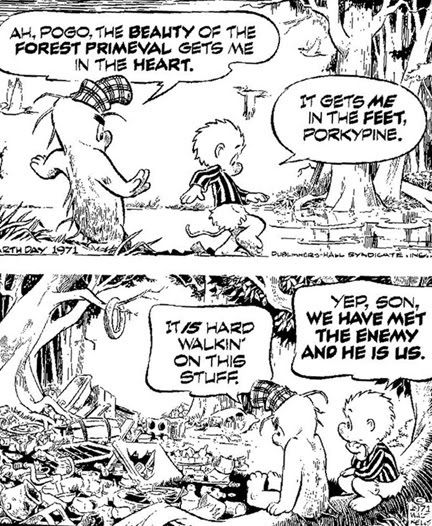Gardner's Book of Mormon Myths: Number 2
Likening With Care, part 7
Today's post continues Gardner's top five myths or misconceptions regarding
the Book of Mormon (see myths five, four, and three). Gardner:

"Myth two would be the idea that 'Nephites wear the white hats and Lamanites wear the black hats.'
It is understandable that we get this impression since the story is of the Nephite nation and all external conflicts are with "Lamanites." However, the flexibility of that socio-political label masks Mormon's insistent message that the worst enemies are those who used to be friends and associates. The worst problems the Nephites have (until their final destruction) come from internal dissension and apostasy. "We have met the enemy, and it is us," to quote the line from Pogo."1
 LoGP:
LoGP:Gardner is referring to cartoonist Walt Kelly's 1971 Earth Day poster depicting what we might call "Pogo's lament."
Gardner believes confining the groups as "Nephite=good, Lamanite=bad" isn't represented so simply in the record itself. In his Book of Mormon commentary Second Witness Gardner views the record as being written much differently from what modern historical conventions would dictate. It is a tribal, or "lineal" account rather than Mormon's academic exercise in presenting history as we might read in textbooks today. For example, in some cases when the record labels the Lamanites in derogatory terms, other details seem to belie such a simplistic description.
Gardner explained:
"In multiple instances, a Nephite describes the Lamanites as lazy and uncivilized. These negative portrayals occur along with descriptions of Lamanite cities that appear more powerful than Nephite cities. This pejorative catalog even gets repeated by Mormon in his abridgment, when it is obviously incorrect. However, the presence of the pejorative characterization is anthropologically accurate for time and place. Rather than attributing it to authorial error, it can be viewed as an accurate replication of typical in-group prejudices that occur in most human populations."2
Thus, Gardner's commentary presents an interesting look at the Lamanites and what caused the continual warfare throughout the Book of Mormon, including a unique view of the rebellions of Laman and Lemuel. A close reading of the text itself reveals the lines were not so neatly drawn between Lamanite and Nephite.This will be discussed further in a future post in this series dealing with "racism in the Book of Mormon."
FOOTNOTES
[1]Brant Gardner, personal email in my possession, Sept. 1, 2008.
[2]
These comments from Gardner are found in Kevin Christensen's "Truth and Method: Reflections on Dan Vogel's Approach to the Book of Mormon," FARMS Review 16:1, 349-350. Gardner's Second Witness notes specific instances when the record's description of the Lamanites is self-contradictory. For example, see the discussion of Enos 1:20-21 in volume 3.




3 comments:
The facile and knee-jerk categorization is too tempting. Just look at how political partisans describe the others. For just one example, "liberal" has gone from a lofty attribute to a negative pejorative.
And, of course, we tend to look at apostates as our worst enemies. One could say that at least the apostate is honest (to some degree at least). More troublesome is the hypocritical pharisee. We certainly can't deny that some of us fall into that category.
I think it is a very interesting way to see the Book of Mormon, as a warning against that mentality.
Morm. 9: 31
Condemn me not because of mine imperfection, neither my father, because of his imperfection, neither them who have written before him; but rather give thanks unto God that he hath made manifest unto you our imperfections, that ye may learn to be more wise than we have been.
أشعة الدوبلر
Post a Comment
All views are welcome when shared respectfully. Use a name or consistent pseudonym rather than "anonymous." Deletions of inflammatory posts will be noted. Thanks for joining the conversation.